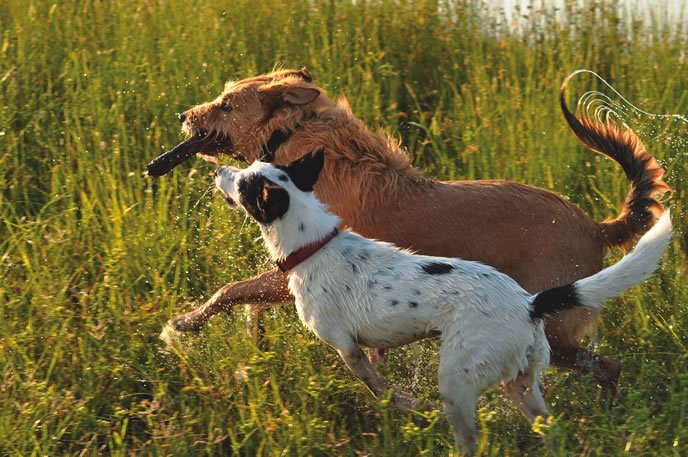
If you’ve ever had little two-leggers in your life, you know that they are issued along with new lenses for the frames of your formerly rose-colored glasses; once you are responsible for a child’s very survival, every object in her environment is assessed through safety lenses for its ability to inflict harm, from the vertigo-inducing monkey bars at the playground to the toxic stew of cleaning products under your kitchen sink.
Eventually, our young humans grow up and assume responsibility for their own safety and survival (though of course, we never completely stop worrying about them).
Perennial grade-schoolers that they are, our dogs never afford us this upgrade. We never have to fret over them running off with the wrong Poodle, or not being able to find a job at the dog park. But we’re stuck with those safety glasses for the lifespan of our dogs, laser-focused on how they interact with the physical world around them, for better or – we fear – worse.
“I wish I could just bubble-wrap him,” said a friend, only half-jokingly, about the toll all this worrying takes on her ability to enjoy her dog.
All conscientious dog owners wrestle with the dilemma: How physical should we allow our dogs to be? How do we balance the risks of letting them indulge their instincts – to let them be dogs – with the desire to keep them in one piece?
While there are no guarantees in life, and freak accidents can happen to anyone, anywhere, anytime, there are some things you can do to keep your dog from winding up in a full body cast.
Limit Your Dog’s Liability
Knowing your dog’s limits is the first step to keeping her safe.
“People sometimes push their dogs too early without paying respect to their physical and mental ability,” says physical therapist Deborah Gross, DPT, MSPT, of Wizard of Paws Physical Rehabilitation for Animals in Colchester, Connecticut, who works with many dogs who do high-impact sports such as agility. “For example, you shouldn’t be starting an 8-month-old pup out on jumps and grids before they have the mental ability to comprehend what they need to do, and before they have the physical strength to perform a movement.”
Waiting for full growth-plate closure before attempting strenuous activities is also key, Gross stresses. The growth plates are those funny-looking, oversized knobs you see on a puppy’s front legs, though they exist in the bones of the rear legs and pelvis, too. As their name suggests, these plates are areas of tissue at either end of the bone that determine how long the bone will grow. They do not “close,” or stop growing, until a dog is around a year old (and closer to two years in larger breeds). Until the growth plates close and are replaced by bone, they are relatively weak and susceptible to injury – which is why it is recommended that puppies are not jogged for long distances on unyielding surfaces such as concrete or blacktop.
Obviously, if your dog engages in higher-impact activities, he’ll have a relatively higher risk of injury, especially if he’s not been thoroughly prepared for those activities with a solid foundation of conditioning. But even an innocent game of catch can do serious harm.
“Ball playing is a big culprit for injuries,” Gross cautions. “Dogs often get crazy and push themselves through injuries. And ball playing is something many owners say they ‘need’ to do to help with their dogs’ activity level.”
Laurie McCauley, DVM, DACVSMR, of Tops Veterinary Rehabilitation in Grayslake, Illinois, who is board-certified in sports medicine and rehabilitation, says ball-throwing can be made safer if you pay attention to the topography.
“If you’re going to throw a ball and you’re on a hill, always be sure to throw the ball uphill,” she advises. Since dogs always run faster when they go after the ball, and are slower to return with it, you don’t want that initial chasing to happen as the dog goes full tilt downhill.
Gross stresses that owners need to understand and look out for the signs of injury in their dogs. “Often the dogs give us subtle signs but we do not pick up on them,” she says. “They may continue to perform an activity with them, and an overuse injury occurs.”
If your dog seems just a little off – or hesitates or refuses to do an activity that she previously was enthused about – a vet visit might be in order. Yawning, boredom, increased fatigue, and stiffness on rising can also be warning signs. The more in tune you are with your dog, the more easily you will pick up when something just “isn’t right”: What your gut is telling you, even though your brain can’t pinpoint it, is that your dog’s response time and body posture have changed, if only subtly, to compensate for the discomfort she feels.
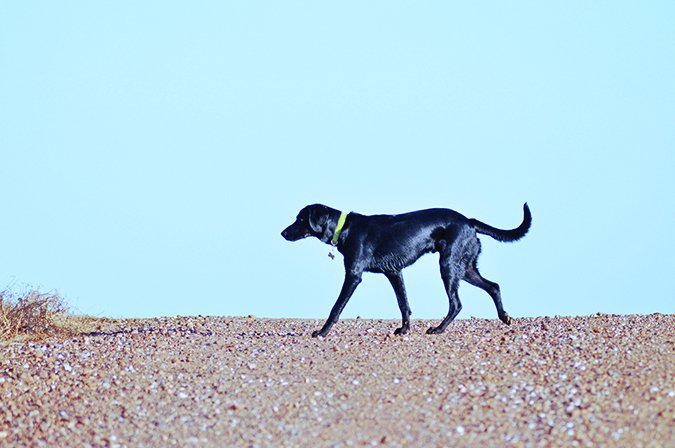
Puppy Pilates
Just like people who don’t exercise all week and then take an embarrassing header at the company volleyball tournament, dogs can’t just jump off the couch and start zooming around like an agility star. Weekend warriors often pay the price for their part-time athleticism with increased injuries that might have been altogether avoidable.
Your solution to the volleyball debacle might be to become a gym rat, and that potential exists for your dog, too. Agility competitors and other performance enthusiasts often use targeted exercises to strengthen a dog’s core – the muscles around the back, abdomen, and pelvis – which in turn help increase stability and balance. The more control a dog has over her body – how she moves and reacts to her changing physical environment – the less likely she is to hurt herself in the process. Core-building equipment includes:
Stability balls. These brightly colored bouncers are now standard issue in human workouts, and dogs love to stand atop them. But the totally spherical surface doesn’t always work as well with quadrupeds, and there are several oval- and peanut-shaped stability balls on the market designed specifically for dogs.
Balance discs. These inflatable PVC discs create an unstable surface that the dog must compensate for by shifting her weight. The more inflated the disc, the more challenging the exercise.
Wobble boards. You can spend close to $100 on one of these fancy boards, or you can make your own with a circle of plywood nailed to a pivot point, like a softball.
Dominick Cenotti
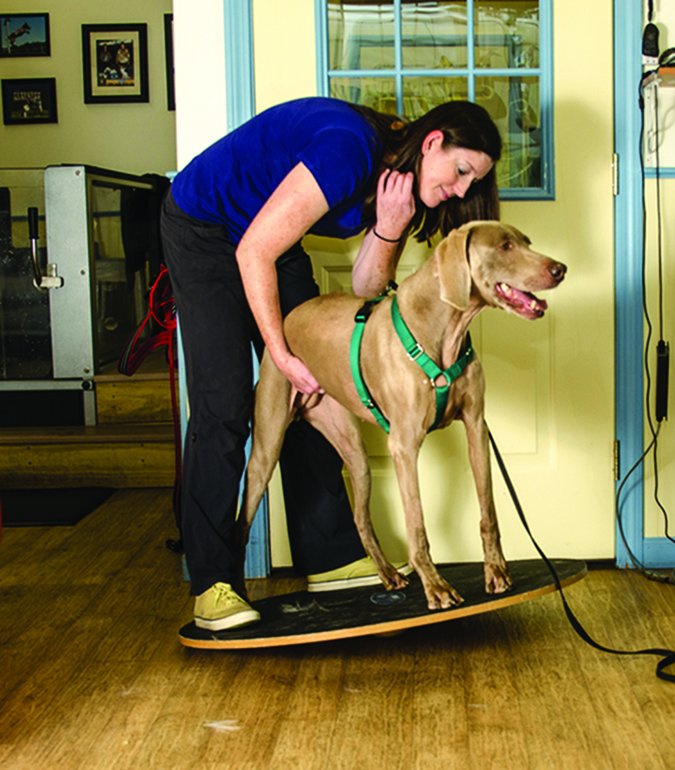
If someone could invest in only one piece of conditioning equipment, Gross recommends a large balance disc. “Most dogs, big or small, can use one,” she says. (Not to mention that you can work out on the disc when your dog isn’t!)
“I love to incorporate core work into the dogs’ daily life,” Gross says, ticking off some of the scenarios: balancing on a disc while your dog is eating, asking her to perform 10 sit-to-stands before feeding, or having her balancing on a piece of balance equipment while you are watching the news.
An even cheaper option is a leash. Gross says it can be tougher for busy owners to find the time to add some endurance exercise into the mix, “but I usually ask people to try to get in at least one 20-minute walk a day – maybe sneak out at lunch, get up 20 minutes earlier, or stay up 20 minutes more.”
Dr. McCauley says one of the best exercises for strengthening a dog’s back end is getting her to walk sideways or backward. “To get her to walk sideways, you can hold onto the dog’s collar, face her perpendicularly, put your feet between her front feet and back feet, and gently walk into her” so she is forced to go sideways, she says.
For backward walking, put a cookie to the dog’s chest and get her to heel backward. Or, place her next to a wall, with a hand on her collar and another on the belly, and gently get her to walk backward. With toy dogs, Dr. McCauley suggests working on a bed to spare your own back. Frequent praise and treats will help your dog to quickly learn what’s expected, and start moving on her own volition.
Courtesy of Wizard of Paws
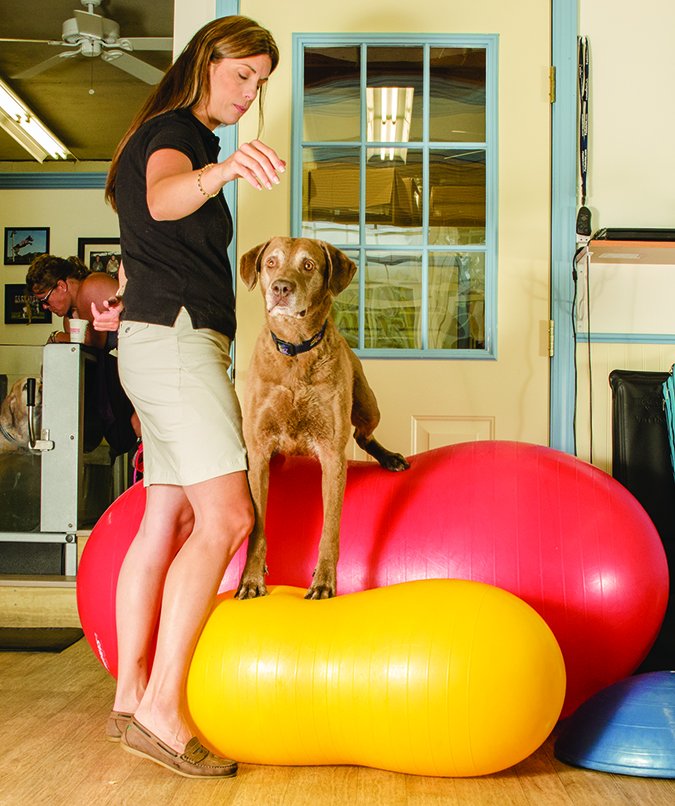
Integrating these exercises into your walks can easily make them part of your routine. “Go a block and then walk a house length sideways,” Dr. McCauley advises. “Then go another block and walk a house length backward.”
If you have the time, resources or budget for it, underwater treadmills are a great way to keep a dog toned and fit. Dr. McCauley says that research shows that underwater treadmills, as well as strengthen training, slow down the progress of sarcopenia, or muscle deterioration associated with the aging process. The research did not address free swimming in a lake or pool, but that certainly can improve overall condition and strength, which in turn lowers your dog’s risk of injury.
Dominick Cenotti
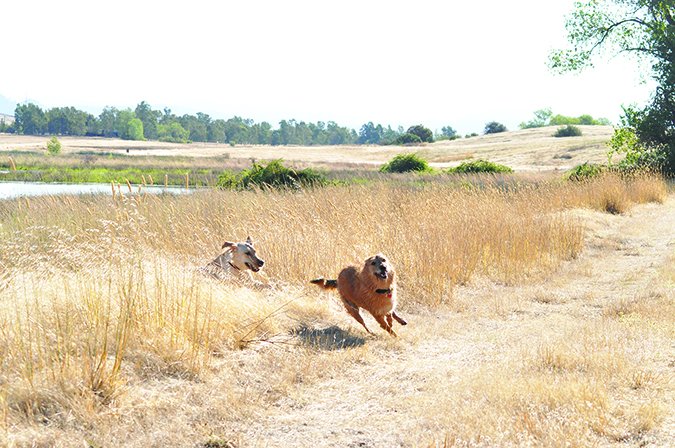
Don’t Substitute Real Physical Activity
Dominic Carota of Hallam Hounds, located in Selkirk, New York, is an internationally known breeder of Pharaoh Hounds. But his hounds don’t just do the cakewalk at dog shows; they are also avid competitors at lure coursing, a sport where dogs chase a plastic bag to simulate a rabbit hunt.
Such a physically demanding sport, where the dogs gallop full on and also make relatively quick turns as their “prey” zips around the field, has its risks; dogs can become severely injured, or even die. But Carota has managed to avoid any serious mishaps in the two decades his dogs have been running. He attributes that to a daily conditioning program that basically amounts to lots of mini-sessions of free-running.
Carota’s dogs are given time to free-run, off leash, four times a day. “It doesn’t have to be long periods – even for 10 minutes,” says Carota, who typically lets five or six dogs run together to give them short bursts of continuous exercise. “They need that lateral movement to build themselves up. It keeps them in condition – and not just physically, but also psychologically.”
Carota has set up his kennel property to include several different levels and surfaces: The dogs cross concrete, dirt, grass, sometimes at an incline, sometimes at a decline. While leash walking is great at building endurance, “the problem with straight walking is it doesn’t do a lot in terms of building agility,” he says. “This builds up their pads, and their pasterns, and gives them the agility to pivot quickly, and turn on a dime. I set up my property so they can do it themselves.”
Anne Jones of Alchemy Dog Training in Acworth, Georgia, is also a fan of what she calls “self-exercise.”
In her wooded backyard, as well as on their weekly off-lead runs in the woods, her dogs bound over uneven ground, negotiating random obstacles, and their bodies have to unconsciously readjust where they are in space and time – what’s formally called proprioception.
Even navigating everyday life gives Jones’ dogs a dose of cross-training. “I live in a house with stairs, and the dogs go up and down the stairs at a run,” says Jones, who has Rhodesian Ridgebacks as well as an Australian Cattle Dog and an ancient Border Collie. “It gives them lots of rear-end exercise.”
For those whose full-time work schedules prevent them from devoting much time to letting their dogs work out, Jones suggests doggie day care.
In that free-form environment, “the dog is out and moving all day,” she says. “It’s not like being crated or being in the house all day.”
Learn About Your Dog’s Conformation
That’s conformation with an “o,” not an “i”: Confirmation is what you get when Amazon sends you an email that your 50 Shades of Grey trilogy has shipped (don’t worry, I won’t tell). Conformation is used among dog people to refer to a dog’s structure, and by extension, how those individual body parts work together to affect a dog’s soundness.
Dog breeders and performance enthusiasts will often talk about whether a dog has a “good front” or “good rear.” This isn’t an aesthetic reference, but rather a description of how the respective assemblies impact the dog’s physical ability. In terms of structure, a “good front” is one in which the scapula, or shoulder, is well-angled: Because some 60 percent of a dog’s weight is borne on the front assembly, a well-angled front acts like a spring, absorbing shock with a minimum of wear and tear. A straight front, in which the shoulder blade is more upright, is less ideal in situations that call for a lot of jumping, such as agility.
Similarly, a “good rear” is one that has strength and stability for the all-important job of pushing off and pivoting. Dogs who have weak, high, or slipped hocks, lack of inner thigh muscle, or narrow stifles or knee joints, are at greater risk of injury.
“Dogs who are straight in the front are much more likely to injure their shoulders,” Dr. McCauley notes. “Dogs who are too straight in the rear are more likely to tear their cruciates, while dogs who are very angled in the rear are more likely to have toe and hock injuries.”
“We always want to stack the cards in the favor of the dogs,” Gross adds. “A long-backed dog should not do a lot of excessive jumping secondary to the stress placed on their backs. Any abnormal conformation will place excessive stress on the dogs’ body and lead to a faster breakdown, and a higher risk of osteoarthritis and injury.”
Dogs who have very long backs – such as Dachshunds – or very short ones – such as French Bulldogs – can be prone to back injuries. But this isn’t always breed-specific: Jones, who breeds Rhodesian Ridgebacks, says she spayed one of her females because she had a “bad topline” – in other words, her back was so long that it had a bit of a dip. “When she jumps, she doesn’t land well, because her shock assembly isn’t working,” Jones says. “The better structure they have, the longer they are going to stay sound.”
This doesn’t apply to just purebred dogs, of course, though good breeders pay a great deal of attention to structure, and so have a heightened awareness of it. Jones, who does rescue work, says she always evaluates her incoming rescues in terms of their conformation, so she can determine their physical limitations.
Another word dog people use is “balance,” which is just what it sounds like: The rear and front assemblies complement each other, and so work in tandem when the dog is in motion. “If they’re unbalanced, they’re not going to run well or fast or very long,” Carota says. “They’re going to tire more quickly.”
That pretty “prance” that you see in a well-made dog trotting by is really a fluid, uninterrupted gait; almost always, it means that the dog’s various parts are working together in balance.
If you have a purebred dog, or a dog whose background seems dominated by a particular breed, do some research to find out whether that breed typically has vulnerable structural or physical characteristics. For example, owners of Greyhounds need to be aware that these dogs have skin so delicate that it often needs to be glued instead of stitched, and so a graze from a passing branch or exuberant mouthing from another dog at the dog park can be more significant for them than most other dogs.
Warming Up Before Exercising
Builders of skyscrapers know that they have to allow for a little swaying; otherwise, high-powered winds can literally snap their towering creations in half. Similarly, even well-made dogs need some “give” in the muscles, tendons, and ligaments that hold them together.
Jones, who competes with her dogs in agility, always does a warm-up before a run. “You don’t want the muscles to be tight,” she says. “I make sure the dogs bend in both directions, and I make sure they trot. If it’s a particularly cold day, I want to keep them moving, and their muscles warm.”
Even if you are just visiting a dog park, as opposed to taking the starting line in a timed event, walk or trot your dog for three to five minutes before turning him loose to take off at top speed, especially if he’s the type who likes to jump right into the fray.
Hydration is always important when a dog is active, because it regulates body temperature, speeds the transport of nutrients, and lubricates joints. To encourage her dogs to take a few slurps, Jones sometimes adds a little frozen Biljac or molasses to the water bucket. Sometimes she’ll use K9 Super Fuel, a muscle-performance powder. “I just want it to flavor the water,” and encourage them to drink, she says.
It should go without saying, but let’s say it anyway: Being overweight is a huge risk factor for injury. Be sure that your dog is in correct weight for his body frame, not just his size: A Bullmastiff and a Ridgeback are about the same height, but they should have very different silhouettes. Though seeing a slight ripple of rib is normal in some breeds, far too many owners tolerate a few extra pounds in their dogs.
To avoid torn cruciate ligaments, a common injury in large-breed dogs, Gross recommends weight management, because fat dogs are simply at greater risk. Alas, in this, as with us, dieting is not the cure-all: She also recommends exercise, including regular walks, core work on a piece of equipment, and slow walking on hills to build up the hind limbs.
When Your Dog’s Had Too Much Fun
Active dogs, especially youngsters, simply don’t understand the concept of moderation when they are having fun, so you have to watch them and enforce occasional rest periods, and stop the action before your dog is exhausted. Jones has noticed that new dog owners are often unaware of this responsibility. “They assume that as long as a dog wants to keep going, it’s okay,” she explains. “They don’t take the role of advocate. They don’t say, ‘Hey, pup, you’re looking a little tired, your tongue’s a little long.’ They just keep going because the dog wants to keep going.”
And that can end tragically. Jones recalls a friend who took her diabetic-alert dog for an afternoon of swimming a couple of years ago. After playing and retrieving for two hours straight, the exuberant pooch went down – a case of exercise-induced collapse.
“I wouldn’t let any dog retrieve for two hours straight – I don’t care if the dog looks happy,” Jones says. “You have to remember, she’s like a 5-year-old child. She doesn’t know when she’s done.”
Knowing when your dog is showing signs of tiring – and stopping at that point – is very important: Even if your dog is nowhere near the point of collapsing, remember that when anyone gets tired, their tendency for mistakes and missteps increases. Frequent breaks are important.
Carota reminds us that fatigue isn’t just physical. When his dogs are done competing on the lure-coursing field, “I make sure they stay quiet,” he says. “When they’re in the van, that’s their down time, their mental and physical recovery period. It lets their bodies completely relax.”
Maintaining a consistent routine has taught Carota’s dogs that once the van door opens, it’s time to get revved up for another run. But their regular crates and bedding, and the closed van door (which also retains the heat or air conditioning, depending on the season), tells them that it’s time to quiet down and recharge for the fun ahead.
When she is doing strengthening exercises with dogs, Dr. McCauley’s goal is to make sure they are tired so that she knows she is strengthening them, but not to the point of making them sore. “Tired is going to take a nap after the work, then getting up and wanting to play,” she explains. “Sore is getting up slowly, and certainly if they are lame.”
Note how your dog is moving the following day, and watch for signs that she may have overexerted herself.
Dr. McCauley says she always looks at three things before and after exercise: a dog’s stance, or how she holds her body statically; her gait, or how she moves; and transitions, or how she goes from a sit to a down, or a down to stand. “After exercise, they should always be the same or better,” she says. “If it’s worse, you’ve done too much, or done the wrong thing.”
Let Them Be Dogs
At the end of the day, you need to make peace with the fact that even if you follow all the above advice, and your dog is the picture of health and conditioning, mishaps may occur.
Jones points to her weekly runs in the woods as a perfect example. “That’s an accident waiting to happen, always,” she says: No amount of preparation or caution can prevent a dog from getting impaled on a protruding branch, or stepping into a hole and twisting a leg.And here is where a bit of philosophy comes into play: Yes, a bubble-wrapped dog is a safe dog. But, ultimately, it is a happy one?
Jones says she has a friend with Whippets who won’t let her dogs play or run loose because of concerns that they will get hurt. The dogs get long, leashed walks together, so they do get more than enough exercise and interaction with each other. Who is to say whether dogs are any less happy or fulfilled if they don’t get the chance to body-slam and chase and jump on each other?
Jones, however, thinks she knows how the dogs would answer if they could.
“There’s nothing my dogs love to do as much as run in the woods,” she says. “Yes, they can hurt themselves, but it gives them so much pleasure. First and foremost, I let them be dogs.”
Denise Flaim of Revodana Ridgebacks in Long Island, New York, shares her home with three Ridgebacks, 11-year-old triplets, and a very patient husband.




